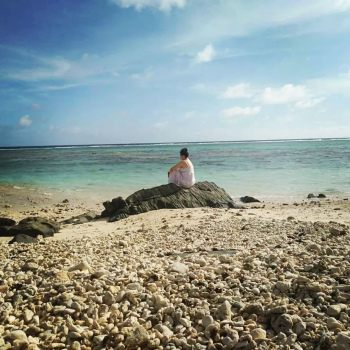At the end of March, my brother and I will be talking to tertiary students based in Aotearoa about our digital work ‘Weaving the Narrative’, a rather unimaginative title for what we created for the Weaving a Narrative commission with Übersee-Museum Bremen and Digital Pasifik. For both of us, it is exciting that this work continues to contribute to conversations about our people and culture as they exist in museum and archival collections. Everytime a Pacific person engages with the work, we have an opportunity to turn someone’s attention to how, where and why our people, our knowledge and our objects are held in collections and also, how we might engage with these platforms as Indigenous creatives.
And by the end of our presentation, we travel towards ways in which these online collections facilitate connection with and between Indigenous people, their objects, time and space.
The video ‘Weaving the Narrative’ speaks to the value of the everyday objects found in collections, in our case, Cook Islands weaving materials. It begins by subverting the premise of the commission and admitting my original application suggested my finished output would be completely different, focused on my own literary process and on one object. The video then narrates my personal journey of searching through the online collections. It alludes to the difficulties I encountered as a va’ine Māori ō Rarotonga, a woman from the Cook Islands. The practices of museums and similar institutions whereby, historically, objects and information was gathered on a cultural and/or ethnic ‘other’ in a way that dismisses Indigenous ontology and values systems is well-documented. So in the video, when I search through the collections, particularly those that hold older and/or less complete objects and archival documents, those legacies were laid bare.
Does this mean I feel it is better for Indigenous peoples to avoid engaging with these collections? Absolutely not. In fact, our engagement is essential. And by the end of our presentation, we travel towards ways in which these online collections facilitate connection with and between Indigenous people, their objects, time and space.
What is particularly valuable about Digital Pasifik is how it allows for people to leave comments. This means that holders of collections can potentially engage with people who have valuable information about objects. However, this does mean that institutions may need to open themselves up to engagement and critique of practices, even confronting the feelings of hurt and loss that some objects may prompt in the communities that created them. But these conversations provide opportunities for enrichment, understanding and ultimately a future where archival and museum collections feed into broader conversations around cultural heritage, rejuvenation and empowerment.
On a more personal note, this process allowed me to work with my brother for the first time. Early in this work, I realised I would need to broaden my creative practice in literary prose in order for it to translate to digital media. My brother specialises in coding and audio production and once I had written the initial draft, we worked closely to develop the final video, even including track that he had recorded with our father. From here we have also produced another work for Dunedin Dream Brokerage and we are now exploring how music can enhance the reading of literary prose. Additionally, I came to learn that no one will offer more honest critique of your practice than your sibling - it’s one way to fast track development of a creative project.
Lastly, this project to connect and work with people who share my passion for our peu Māori (culture) across my community here in Ōtepoti. I now know firsthand that when Indigenous people gather to talk about the things they discover on platforms such as Digital Pasifik, it can be the beginning of many journeys and conversations that help us explore who we are and what is important to us.
